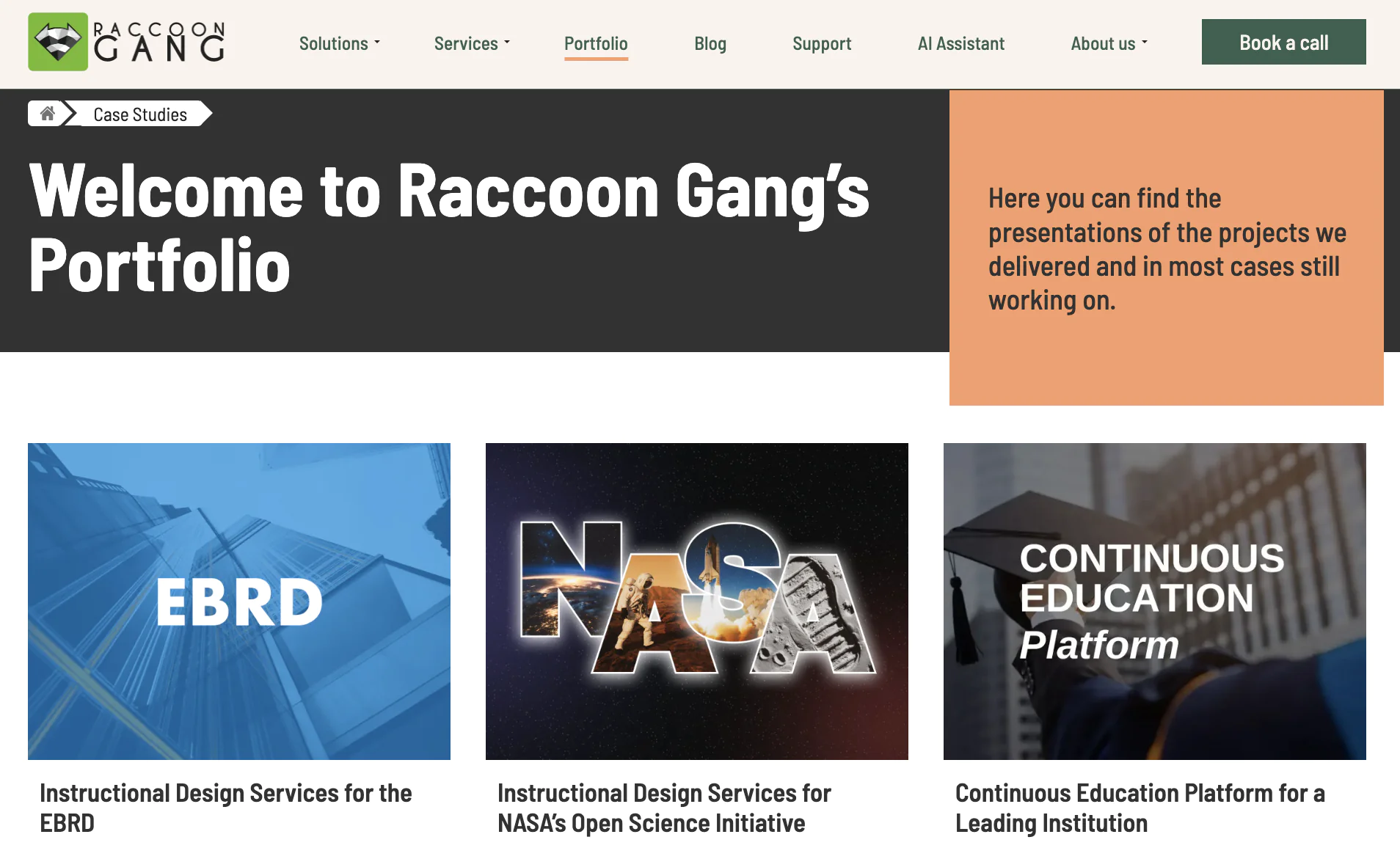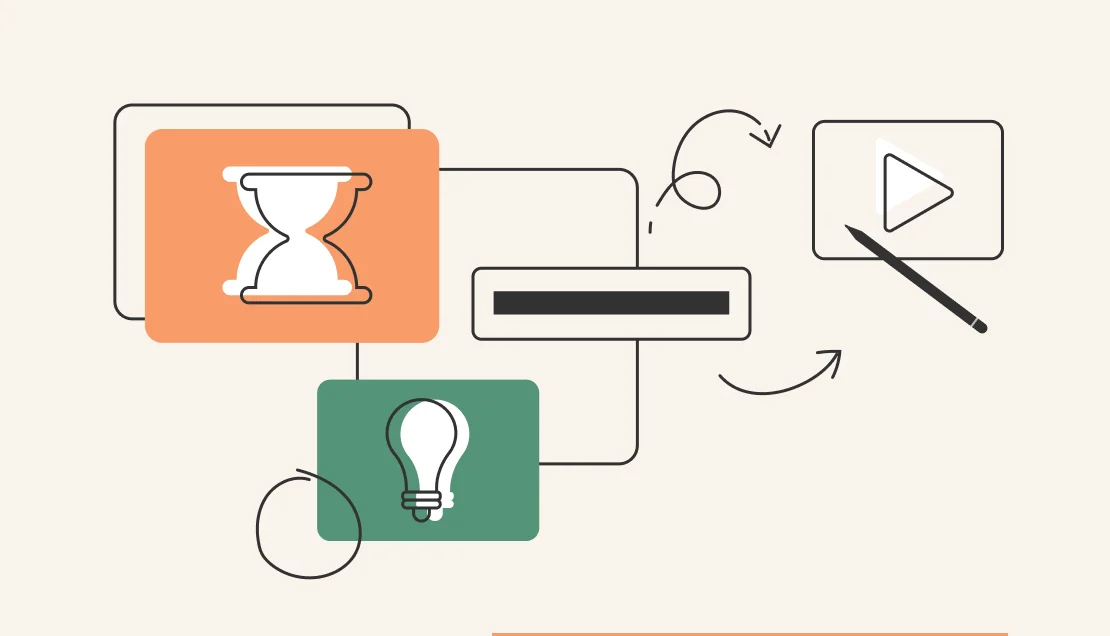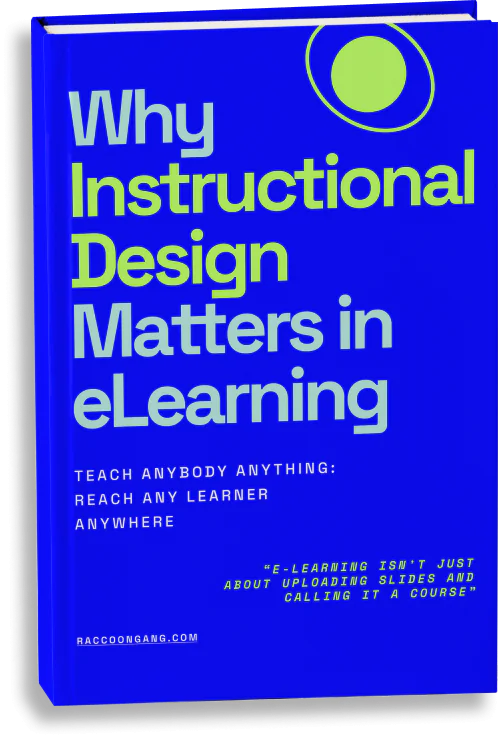Course Development Cost by Component
Back in 2010, the Chapman Alliance conducted a comprehensive study on online course development. It showed that the cost of curriculum development for one hour could be around $10,000. You might wonder why it is ‘around.’ The logic is simple. The price tag escalates with feature enhancements and the quest for increased dynamism and interactivity in the course. What are the key factors to consider when calculating the cost of curriculum development?
1. Time vs. Money Tradeoff
Like in any other business, producing an online course involves a tradeoff between time, money, and quality. Building the course yourself can save you money, but it requires a substantial time investment to create quality content.
On the other hand, outsourcing the course creation to a third party like Raccoon Gang will save time and allow you to focus on your core expertise. Ensuring high content quality is another crucial reason to delegate content creation to pros. However, in this case the cost to develop a training program will be significantly higher.
2. Focus on Value
Rather than asking, ‘How much does it cost to create an online course?’ and going after low expenses, focus on the course’s perceived worth. How much time and effort will your students save by learning from you instead of trying to figure things out themselves? If you are creating online training for employees, consider the revenue it will generate.
Knowing your learners’ pain points and how your course addresses them helps in designing the proper content. Offer excellent quality content that’s well-made and useful for your target audience. That’s what brings the dough.
3. Learner’s Participation Type
The price for online course development increases with the level of learner participation. Passive courses with minimal interaction are the cheapest and quickest to develop. As courses become more interactive, features like simulations and branching scenarios require more development time and expertise, driving up the cost. Due to the complexity of the interactive elements, expect to pay the most for the most practical skill training. To manage these costs efficiently, many organizations turn to software outsourcing services, allowing them to access specialized expertise while optimizing development expenses.
4. The Cost Variables
How much does it cost to create an online course? It all depends on several critical aspects, including the complexity and length of the content, the content delivery mode, and the topic and quality of the content.
If you’ve got lots of details or need unique stuff, it’s going to cost you more. On the flip side, if you’ve already got some materials or can do some of the work in-house, you can save.
Human effort and labor account for the lion’s share of the cost of online course development services. Developing online courses requires a team of specialists who take on specific tasks. This is trailed by the expense incurred on equipment and software necessary for the task.
If you decide to take the reins and build the online course yourself, you’re essentially incurring minimal costs beyond the value of your time.
An Overall Cost to Develop an Online Course
To make a long story short, let’s look at the overall cost of creating a training program. One hour of eLearning development costs around 19 thousand US dollars. The numbers are based on information as of January 2025 about developing an online course from scratch.
As mentioned above, human efforts are the main expenses. Creating instructional content is almost impossible without a team of specialists who take on specific tasks.
The Hidden Costs of eLearning: The Human Factor
- SME or Subject Matter Expert is a specialist in the field in which your course will provide training material. They are engaged in research, text writing, lecture notes, and much more. Instructional design services are essential to ensuring that the course is pedagogically sound and learner-centered, making the training more effective.
- The instructional design team includes graphic designers, camera operators, video editors, and others.
- Project Manager is a course owner who oversees all aspects of course development and overall progress.
- Technical staff specialists are people responsible for the technical part of course creation (e.g., QA engineers, DevOps specialists, content managers, and others).
The professionals’ salaries will be the main component of the eLearning development costs. All subsequent information is collected from open recruitment sites (Upwork, SalaryExpert.com, Indeed.com). RacoonGang experts combined the data with our own experience in tailoring custom online learning solutions and created the numbers in the following charts.
| Team roles | Involvement stages | Time, hrs | Rate,$ | Final paycheck,$ |
| Course owner | All | Individual | Individual | Individual |
| SME | Design | Individual | Individual | Individual |
| PM | All | 40-55 | 30-95 | 1200-5225 |
| Instructional designer | Design, development | 50-79 | 20-60 | 1000-4740 |
| Marketer | Analysis | 30-40 | 20-75 | 600-3000 |
| Lecturer | Design, development | 53-84 | 20-50 | 1060-4200 |
| Psycholinguist | Design, development | 20-35 | 30-45 | 600-1575 |
| Graphic designer | Design, development | 59-86 | 15-45 | 885-3870 |
| Director | Development | 3-5 | 40-125 | 120-625 |
| Video operator | Development | 3-5 | 10-60 | 30-300 |
| Video Editor | Development | 51-110 | 15-60 | 765-6600 |
| Content manager | Implementation | 32-43 | 15-75 | 480-3225 |
| Overall cost,$ | 6740-33360 | |||
In the chart below, you can see how numbers evolved during 2021-2025. This is the precise answer to the question of ‘How much does it cost to create a training program?’
| Year | 1 hour of eLearning content costs $ |
| 2025 | 6,740 – 33,360 (20,050 on average) |
| 2024 | 7,520 – 31,965 (19,743 on average) |
| 2023 | 8,425 – 34,525 (21,475 on average) |
| 2022 | 8,542 – 36,320 (22,431 on average) |
| 2021 | 8,150 – 36,205 (22,178 on average) |
In the following sections, we’ll present a detailed analysis of how much does it cost to create a curriculum and a breakdown of participants’ roles in creating the course.
How Much Does it Cost to Build an Online Course? 5 Key Steps to Evaluate
Before developing an online course, it’s crucial to understand the various stages and costs involved. From initial analysis to implementation, each phase plays an important role in creating an engaging online learning experience. We will review the final expense estimate for each participant in the cost to develop a training course.
Stage #1. Analysis and Its Cost
How to develop an online course and make it sell? You hardly want your course to go unnoticed and be a dead weight. That is why it is essential to conduct an analysis. It will help clarify the feasibility of creating a course from an economic and social perspective.
The analysis stage includes researching the following aspects:
- Target audience
- Competition in the selected niche
- Possible and preferred ways of promotion
How much does it cost to create a training program, specifically the analysis stage?
| Team roles | Involvement stages | Time, hrs | Hourly rate, $ | Overall check, $ |
| Course owner | All | Individual | Individual | Individual |
| Marketing specialists | Analysis | 30-40 | 20-75 | 600-3000 |
Once the analysis stage is set and done, it’s time to proceed to the design sequence.
Stage #2. Design Cost
The design phase in eLearning course development constitutes a significant portion of the overall cost. This includes creating the syllabus and topics and defining the course’s overall design and style. The cost varies depending on the complexity of the content and the visual elements incorporated into the course.
| Phase name | Specialists involved | Time, hrs | Upwork rates,$ | Contractors’ rates,$ | Experts’ rates,$ | Overall check,$ |
| Consultations with SME | SME | 10-15 | Individual | Individual | Individual | Individual |
| Psycholinguist | 10-15 | 30-45 | 30-45 | 45+ | 300-675 | |
| Lecturer | 10-15 | 15-40 | 20-50 | 50+ | 200-750 | |
| PM | 10-15 | 20-80 | 30-95 | 95+ | 300-1425 | |
| Instructional designer | 10-15 | 15-50 | 30-60 | 60+ | 200-900 | |
| Designing visual content | Lecturer | 24-36 | 15-40 | 20-50 | 50+ | 480-1800 |
| Instructional designer | 24-36 | 15-50 | 20-60 | 60+ | 480-2160 | |
| Graphic designer | 24-36 | 15-50 | 15-45 | 45+ | 360-1620 | |
| Designing practical tasks | Lecturer | 6-8 | 15-40 | 20-50 | 50+ | 120-400 |
| Instructional designer | 6-8 | 15-50 | 20-60 | 60+ | 120-480 |
Note: How to develop an online course and save some resources? You must have well-organized “face-to-face training content” rich in various media materials, visual content, and more. This content will help you quickly create a course storyboard for subsequent structuring, addition, alteration, and other integral operations of online course development.
Stage #3. Development Price
Development costs for online courses include course and lesson development, content creation, and the necessary online course equipment. These expenses are crucial for creating high-quality and engaging online learning experiences. Proper budgeting and resource allocation for online course development costs are essential for the success of the educational program.
How much will that cost you?
| Phase name | Specialists involved | Time, hrs | Upwork rates,$ | Contractors’ rates,$ | Experts’ rates,$ | Overall check,$ |
| Writing notes | Lecturer | 10-20 | 15-40 | 20-50 | 50+ | 200-1000 |
| Instructional designer | 10-20 | 15-50 | 20-60 | 60+ | 200-1200 | |
| Psycholinguist | 10-20 | 30-45 | 30-45 | 45+ | 300-900 | |
| Video guideline design | Graphic designer | 15-20 | 15-50 | 15-45 | 45+ | 225-900 |
| Video Editor | 15-20 | 20-40 | 15-60 | 60+ | 225-1200 | |
| Shooting videos | Lecturer | 3-5 | 15-40 | 20-50 | 50+ | 60-250 |
| Video operator | 3-5 | 25-70 | 10-60 | 60+ | 30-300 | |
| Director | 3-5 | 35-100 | 40-125 | 125+ | 120-625 | |
| Intro design | Graphic designer | 20-30 | 15-50 | 15-45 | 45+ | 300-1350 |
| Video Editor | 20-30 | 12-40 | 15-60 | 60+ | 300-1800 | |
| Editing videos | Video Editor | 16-20 | 20-40 | 15-60 | 60+ | 240-1200 |
Stage #4. Implementation Price
So, all the training material is ready, and now is the time to add it to your chosen LMS. You can either create an online course platform on your own or choose an existing one.
However, this is not just a process of “pouring” content into the system. It is necessary to fully transform it into a ready-made course using the LMS tools. In addition, proofreading and error checking are critical to ensuring the maximum quality of the finished course.
| Phase name | Specialists involved | Time, hrs | Upwork rates,$ | Contractors’ rates,$ | Experts’ rates,$ | Overall check,$ |
| Course upload | Content manager | 2-3 | 15-60 | 15-75 | 75+ | 30-225 |
| Content manager | 30-40 | 15-60 | 15-75 | 75+ | 450-3000 | |
| QA | PM | 30-40 | 20-80 | 30-95 | 95+ | 900-3800 |
| Course owner | 30-40 | Individual | Individual | Individual | Individual | |
| Course creation monitoring | Course owner | 2-3 (daily) | Individual | Individual | Individual | Individual |
| Project management | PM | 2-3 (daily) | 20-80 | 30-95 | 95+ | 60-285 |
Also, the LMS setup is included in the final check.
| Team member | Hours | Hourly rate, $ | Overall check, $ |
| DevOps Engineer | 50-80 | 50-100 | 2500-8000 |
| Quality Assurance Specialist | 15-50 | 20-60 | 300-3000 |
Note: All of the above roles can be combined to a certain degree in one specialist, for example, a video operator and a video editor in one person. The development stages can also be combined. These two facts can reduce the cost of development stages by 30%.
Create and Manage Online Courses with the Open edX Platform
The Open edX platform is an open-source learning management system. This LMS allows you to create online courses on any scale. The platform is an example of suitable solutions for e-learning businesses, and is free to use.
However, some costs are associated with setting up and running an online course on Open edX.
- Setup and Configuration. Although the Open edX platform is free, setting it up requires technical knowledge. You may need to hire an Open edX developer or a team to do the initial setup and configuration. This includes installing the platform, setting up the servers, and configuring the software to meet your specific needs. The cost can vary depending on the complexity of the setup and the hourly rates of the developers.
- Curriculum Development Cost. Just like with any other platform, you will need to create the course content. This includes writing the course materials, creating multimedia content, designing quizzes and assessments, and more. The cost can vary depending on the length and complexity of the course and the rates of the professionals involved in the creation process. We covered this topic in detail in previous sections.
- Maintenance and Upgrades. The Open edX platform is regularly updated with new features and improvements. To keep your platform running smoothly and take advantage of these updates, you will need to maintain and upgrade your installation regularly. This may require the services of a developer or a team, which will add to the costs.
- Hosting. The Open edX platform needs to be hosted on a server. You can choose to host it on your servers or use a hosting service. The cost of Open edX deployment can vary depending on the size of your course, the number of students, and the hosting provider you choose.
The Benefits of Open edX: A Closer Look
- Open-Source. The platform itself provides an open-source solution for developing and delivering online courses.
- Scalability. Open edX allows the creation of large-scale online courses, making it suitable for organizations looking to reach a broad audience.
- Customization. The software can be tailored to meet specific needs, allowing for tailored course development and delivery.
- Regular Updates. The platform is regularly updated with new features and improvements, ensuring that users can benefit from the latest developments in online learning.
SaaS LMS for Online Courses
If you’re exploring alternatives to managing the costs and complexities associated with setting up and running an online course on the LMS like Open edX, consider Tanuki – the SaaS LMS for Online Courses by Raccoon Gang.
Tanuki presents an efficient and innovative LMS subscription service that takes advantage of the powerful Open edX platform. By choosing Tanuki, you can significantly simplify the process of creating, organizing, and delivering online courses.
This comprehensive SaaS solution streamlines the complexities associated with managing the costs of setting up and running an online course. With Tanuki, you can enjoy a hassle-free approach to online course management, ensuring a seamless experience for both instructors and learners.
Summary – Cost to Create an Online Course
Online course development is a multi-stage and complex process, and thoroughly knowing the price in advance is impossible. Too many variables in the final price tag equation affect eLearning development costs. To get an accurate estimate, you should contact the experts in online course creation and book a demo to learn all the details.
Remember, the most successful courses require constant revision and improvement to correspond to today’s realities. Considering the trends in eLearning, it’s clear that online course development is a worthwhile investment.
Whether you’re planning to create your first online course or looking to improve an existing one, we hope this article has provided you with valuable insights and guidance.
Partner with Experts Who’ve Been Developing Online Courses Since 2015
Hiring reliable partners can significantly save you time and money in developing an online course. Racoon Gang has been creating online courses since 2015, offering the necessary expertise to provide a full-cycle implementation for eLearning projects.
We deliver impressive projects for companies like NASA, EBRD, Salmon Trust, Harvard, and UCLA. These case studies demonstrate Racoon Gang’s expertise in online course development and provide valuable insights into the process and outcomes.
FAQ
How much does it cost to create an online course?
What does it take to build an online course?
How long does it take to develop 1 hour of eLearning?
What are the hidden costs of online course creation?
Hidden costs may include:
-
Ongoing software subscriptions
-
Content updates and maintenance
-
Course hosting fees
-
Copyrighted content licensing
-
Paid marketing or ad campaigns
Planning for these in your budget helps avoid surprises later.
How does the choice of eLearning authoring tools or platforms impact the cost estimate?
- Course Development Cost by ComponentBack in 2010, the Chapman Alliance conducted a comprehensive study on online course development. It showed that the cost of curriculum development for one hour could be around $10,000. You might wonder why it is ‘around.’ The logic is simple. The price tag escalates with feature enhancements and the quest for increased dynamism and interactivity in the course. What are the key factors to consider when calculating the cost of curriculum development?1. Time vs. Money TradeoffLike in any other business, producing an online course involves a tradeoff between time, money, and quality. Building the course yourself can save you money, but it requires a substantial time investment to create quality content.On the other hand, outsourcing the course creation to a third party like Raccoon Gang will save time and allow you to focus on your core expertise. Ensuring high content quality is another crucial reason to delegate content creation to pros. However, in this case the cost to develop a training program will be significantly higher.2. Focus on ValueRather than asking, ‘How much does it cost to create an online course?’ and going after low expenses, focus on the course’s perceived worth. How much time and effort will your students save by learning from you instead of trying to figure things out themselves? If you are creating online training for employees, consider the revenue it will generate.Knowing your learners’ pain points and how your course addresses them helps in designing the proper content. Offer excellent quality content that’s well-made and useful for your target audience. That’s what brings the dough.3. Learner’s Participation TypeThe price for online course development increases with the level of learner participation. Passive courses with minimal interaction are the cheapest and quickest to develop. As courses become more interactive, features like simulations and branching scenarios require more development time and expertise, driving up the cost. Due to the complexity of the interactive elements, expect to pay the most for the most practical skill training. To manage these costs efficiently, many organizations turn to software outsourcing services, allowing them to access specialized expertise while optimizing development expenses.4. The Cost VariablesHow much does it cost to create an online course? It all depends on several critical aspects, including the complexity and length of the content, the content delivery mode, and the topic and quality of the content.If you’ve got lots of details or need unique stuff, it’s going to cost you more. On the flip side, if you’ve already got some materials or can do some of the work in-house, you can save.Human effort and labor account for the lion’s share of the cost of online course development services. Developing online courses requires a team of specialists who take on specific tasks. This is trailed by the expense incurred on equipment and software necessary for the task.If you decide to take the reins and build the online course yourself, you’re essentially incurring minimal costs beyond the value of your time.An Overall Cost to Develop an Online CourseTo make a long story short, let’s look at the overall cost of creating a training program. One hour of eLearning development costs around 19 thousand US dollars. The numbers are based on information as of January 2025 about developing an online course from scratch.As mentioned above, human efforts are the main expenses. Creating instructional content is almost impossible without a team of specialists who take on specific tasks.The Hidden Costs of eLearning: The Human Factor SME or Subject Matter Expert is a specialist in the field in which your course will provide training material. They are engaged in research, text writing, lecture notes, and much more. Instructional design services are essential to ensuring that the course is pedagogically sound and learner-centered, making the training more effective. The instructional design team includes graphic designers, camera operators, video editors, and others. Project Manager is a course owner who oversees all aspects of course development and overall progress. Technical staff specialists are people responsible for the technical part of course creation (e.g., QA engineers, DevOps specialists, content managers, and others). The professionals’ salaries will be the main component of the eLearning development costs. All subsequent information is collected from open recruitment sites (Upwork, SalaryExpert.com, Indeed.com). RacoonGang experts combined the data with our own experience in tailoring custom online learning solutions and created the numbers in the following charts. Team roles Involvement stages Time, hrs Rate,$ Final paycheck,$ Course owner All Individual Individual Individual SME Design Individual Individual Individual PM All 40-55 30-95 1200-5225 Instructional designer Design, development 50-79 20-60 1000-4740 Marketer Analysis 30-40 20-75 600-3000 Lecturer Design, development 53-84 20-50 1060-4200 Psycholinguist Design, development 20-35 30-45 600-1575 Graphic designer Design, development 59-86 15-45 885-3870 Director Development 3-5 40-125 120-625 Video operator Development 3-5 10-60 30-300 Video Editor Development 51-110 15-60 765-6600 Content manager Implementation 32-43 15-75 480-3225 Overall cost,$ 6740-33360 In the chart below, you can see how numbers evolved during 2021-2025. This is the precise answer to the question of ‘How much does it cost to create a training program?’ Year 1 hour of eLearning content costs $ 2025 6,740 – 33,360 (20,050 on average) 2024 7,520 – 31,965 (19,743 on average) 2023 8,425 – 34,525 (21,475 on average) 2022 8,542 – 36,320 (22,431 on average) 2021 8,150 – 36,205 (22,178 on average) In the following sections, we’ll present a detailed analysis of how much does it cost to create a curriculum and a breakdown of participants’ roles in creating the course.How Much Does it Cost to Build an Online Course? 5 Key Steps to EvaluateBefore developing an online course, it’s crucial to understand the various stages and costs involved. From initial analysis to implementation, each phase plays an important role in creating an engaging online learning experience. We will review the final expense estimate for each participant in the cost to develop a training course.Stage #1. Analysis and Its CostHow to develop an online course and make it sell? You hardly want your course to go unnoticed and be a dead weight. That is why it is essential to conduct an analysis. It will help clarify the feasibility of creating a course from an economic and social perspective.The analysis stage includes researching the following aspects: Target audience Competition in the selected niche Possible and preferred ways of promotion How much does it cost to create a training program, specifically the analysis stage? Team roles Involvement stages Time, hrs Hourly rate, $ Overall check, $ Course owner All Individual Individual Individual Marketing specialists Analysis 30-40 20-75 600-3000 Once the analysis stage is set and done, it’s time to proceed to the design sequence.Stage #2. Design CostThe design phase in eLearning course development constitutes a significant portion of the overall cost. This includes creating the syllabus and topics and defining the course’s overall design and style. The cost varies depending on the complexity of the content and the visual elements incorporated into the course. Phase name Specialists involved Time, hrs Upwork rates,$ Contractors’ rates,$ Experts’ rates,$ Overall check,$ Consultations with SME SME 10-15 Individual Individual Individual Individual Psycholinguist 10-15 30-45 30-45 45+ 300-675 Lecturer 10-15 15-40 20-50 50+ 200-750 PM 10-15 20-80 30-95 95+ 300-1425 Instructional designer 10-15 15-50 30-60 60+ 200-900 Designing visual content Lecturer 24-36 15-40 20-50 50+ 480-1800 Instructional designer 24-36 15-50 20-60 60+ 480-2160 Graphic designer 24-36 15-50 15-45 45+ 360-1620 Designing practical tasks Lecturer 6-8 15-40 20-50 50+ 120-400 Instructional designer 6-8 15-50 20-60 60+ 120-480 Note: How to develop an online course and save some resources? You must have well-organized “face-to-face training content” rich in various media materials, visual content, and more. This content will help you quickly create a course storyboard for subsequent structuring, addition, alteration, and other integral operations of online course development.Stage #3. Development PriceDevelopment costs for online courses include course and lesson development, content creation, and the necessary online course equipment. These expenses are crucial for creating high-quality and engaging online learning experiences. Proper budgeting and resource allocation for online course development costs are essential for the success of the educational program.How much will that cost you? Phase name Specialists involved Time, hrs Upwork rates,$ Contractors’ rates,$ Experts’ rates,$ Overall check,$ Writing notes Lecturer 10-20 15-40 20-50 50+ 200-1000 Instructional designer 10-20 15-50 20-60 60+ 200-1200 Psycholinguist 10-20 30-45 30-45 45+ 300-900 Video guideline design Graphic designer 15-20 15-50 15-45 45+ 225-900 Video Editor 15-20 20-40 15-60 60+ 225-1200 Shooting videos Lecturer 3-5 15-40 20-50 50+ 60-250 Video operator 3-5 25-70 10-60 60+ 30-300 Director 3-5 35-100 40-125 125+ 120-625 Intro design Graphic designer 20-30 15-50 15-45 45+ 300-1350 Video Editor 20-30 12-40 15-60 60+ 300-1800 Editing videos Video Editor 16-20 20-40 15-60 60+ 240-1200 Stage #4. Implementation PriceSo, all the training material is ready, and now is the time to add it to your chosen LMS. You can either create an online course platform on your own or choose an existing one.However, this is not just a process of “pouring” content into the system. It is necessary to fully transform it into a ready-made course using the LMS tools. In addition, proofreading and error checking are critical to ensuring the maximum quality of the finished course. Phase name Specialists involved Time, hrs Upwork rates,$ Contractors’ rates,$ Experts’ rates,$ Overall check,$ Course upload Content manager 2-3 15-60 15-75 75+ 30-225 Content manager 30-40 15-60 15-75 75+ 450-3000 QA PM 30-40 20-80 30-95 95+ 900-3800 Course owner 30-40 Individual Individual Individual Individual Course creation monitoring Course owner 2-3 (daily) Individual Individual Individual Individual Project management PM 2-3 (daily) 20-80 30-95 95+ 60-285 Also, the LMS setup is included in the final check. Team member Hours Hourly rate, $ Overall check, $ DevOps Engineer 50-80 50-100 2500-8000 Quality Assurance Specialist 15-50 20-60 300-3000 Note: All of the above roles can be combined to a certain degree in one specialist, for example, a video operator and a video editor in one person. The development stages can also be combined. These two facts can reduce the cost of development stages by 30%.[cta-green t="Planning to develop an online course?" d=" We are ready to become your full-cycle eLearning project implementation partner."]Create and Manage Online Courses with the Open edX PlatformThe Open edX platform is an open-source learning management system. This LMS allows you to create online courses on any scale. The platform is an example of suitable solutions for e-learning businesses, and is free to use.However, some costs are associated with setting up and running an online course on Open edX. Setup and Configuration. Although the Open edX platform is free, setting it up requires technical knowledge. You may need to hire an Open edX developer or a team to do the initial setup and configuration. This includes installing the platform, setting up the servers, and configuring the software to meet your specific needs. The cost can vary depending on the complexity of the setup and the hourly rates of the developers. Curriculum Development Cost. Just like with any other platform, you will need to create the course content. This includes writing the course materials, creating multimedia content, designing quizzes and assessments, and more. The cost can vary depending on the length and complexity of the course and the rates of the professionals involved in the creation process. We covered this topic in detail in previous sections. Maintenance and Upgrades. The Open edX platform is regularly updated with new features and improvements. To keep your platform running smoothly and take advantage of these updates, you will need to maintain and upgrade your installation regularly. This may require the services of a developer or a team, which will add to the costs. Hosting. The Open edX platform needs to be hosted on a server. You can choose to host it on your servers or use a hosting service. The cost of Open edX deployment can vary depending on the size of your course, the number of students, and the hosting provider you choose. The Benefits of Open edX: A Closer Look Open-Source. The platform itself provides an open-source solution for developing and delivering online courses. Scalability. Open edX allows the creation of large-scale online courses, making it suitable for organizations looking to reach a broad audience. Customization. The software can be tailored to meet specific needs, allowing for tailored course development and delivery. Regular Updates. The platform is regularly updated with new features and improvements, ensuring that users can benefit from the latest developments in online learning. SaaS LMS for Online CoursesIf you’re exploring alternatives to managing the costs and complexities associated with setting up and running an online course on the LMS like Open edX, consider Tanuki – the SaaS LMS for Online Courses by Raccoon Gang.Tanuki presents an efficient and innovative LMS subscription service that takes advantage of the powerful Open edX platform. By choosing Tanuki, you can significantly simplify the process of creating, organizing, and delivering online courses.This comprehensive SaaS solution streamlines the complexities associated with managing the costs of setting up and running an online course. With Tanuki, you can enjoy a hassle-free approach to online course management, ensuring a seamless experience for both instructors and learners.Summary – Cost to Create an Online CourseOnline course development is a multi-stage and complex process, and thoroughly knowing the price in advance is impossible. Too many variables in the final price tag equation affect eLearning development costs. To get an accurate estimate, you should contact the experts in online course creation and book a demo to learn all the details.Remember, the most successful courses require constant revision and improvement to correspond to today’s realities. Considering the trends in eLearning, it’s clear that online course development is a worthwhile investment.Whether you’re planning to create your first online course or looking to improve an existing one, we hope this article has provided you with valuable insights and guidance.Partner with Experts Who’ve Been Developing Online Courses Since 2015Hiring reliable partners can significantly save you time and money in developing an online course. Racoon Gang has been creating online courses since 2015, offering the necessary expertise to provide a full-cycle implementation for eLearning projects. We deliver impressive projects for companies like NASA, EBRD, Salmon Trust, Harvard, and UCLA. These case studies demonstrate Racoon Gang's expertise in online course development and provide valuable insights into the process and outcomes.→ Go to Portfolio[faq title="FAQ"][faq-item question="How much does it cost to create an online course?"] The cost to create an online course can range from $200 to over $50,000, depending on the scope. A basic DIY course may only require tools and time. A full-featured, professionally produced course—especially with video, animations, or assessments—can cost $10,000–$50,000+. [/faq-item][faq-item question="What does it take to build an online course?"] To create a training program, you need meticulous planning, content creation, instructional design, technical setup, and rigorous quality assurance. From structuring course content to integrating multimedia elements and ensuring seamless user experience, each step contributes to the comprehensive development process. [/faq-item][faq-item question="How long does it take to develop 1 hour of eLearning?"] The time required to develop one hour of e-learning content varies based on complexity, multimedia integration, and team proficiency. Typically ranging from 40 to 160 hours, the development process encompasses thorough planning, content creation, multimedia production, and quality testing to ensure optimal learning outcomes.[/faq-item][faq-item question="What are the hidden costs of online course creation?"]Hidden costs may include: Ongoing software subscriptions Content updates and maintenance Course hosting fees Copyrighted content licensing Paid marketing or ad campaigns Planning for these in your budget helps avoid surprises later.[/faq-item][faq-item question="How does the choice of eLearning authoring tools or platforms impact the cost estimate?"]The choice of e-learning authoring tools or platforms significantly impacts cost estimates due to licensing fees, learning curve considerations, feature variations, and integration demands. While some tools offer robust features with higher costs, others may provide more budget-friendly options, necessitating a careful evaluation of features versus expenses for optimal course development.[/faq-item] [/faq]
- An Overall Cost to Develop an Online Course
- How Much Does it Cost to Build an Online Course? 5 Key Steps to Evaluate
- Create and Manage Online Courses with the Open edX Platform
- Summary – Cost to Create an Online Course






